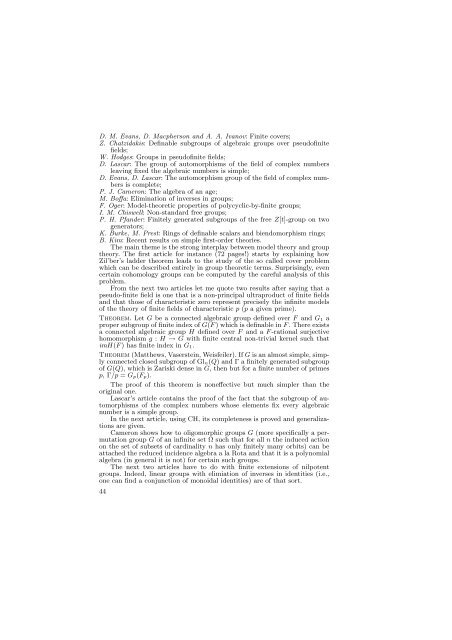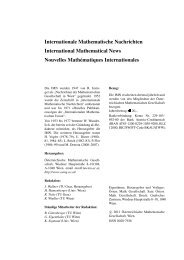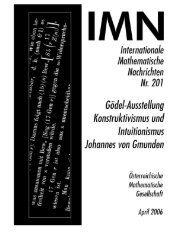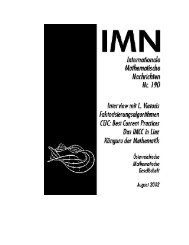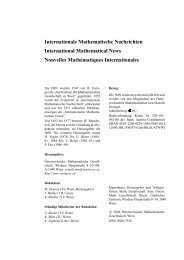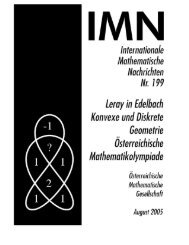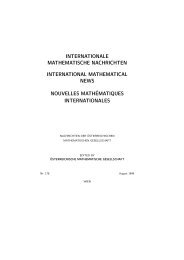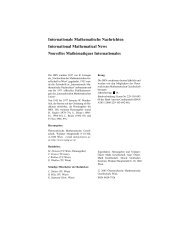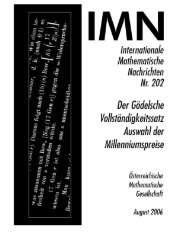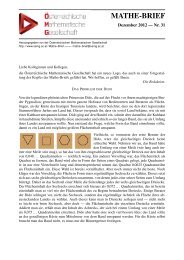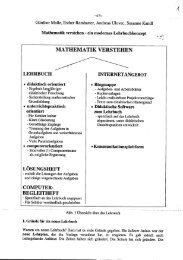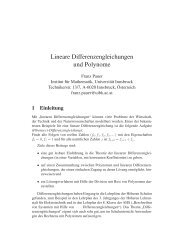Eine Herausforderung für die Mathematik(didaktik)?
Eine Herausforderung für die Mathematik(didaktik)?
Eine Herausforderung für die Mathematik(didaktik)?
Sie wollen auch ein ePaper? Erhöhen Sie die Reichweite Ihrer Titel.
YUMPU macht aus Druck-PDFs automatisch weboptimierte ePaper, die Google liebt.
D. M. Evans, D. Macpherson and A. A. Ivanov: Finite covers;<br />
Z. Chatzidakis: Definable subgroups of algebraic groups over pseudofinite<br />
fields;<br />
W. Hodges: Groups in pseudofinite fields;<br />
D. Lascar: The group of automorphisms of the field of complex numbers<br />
leaving fixed the algebraic numbers is simple;<br />
D. Evans, D. Lascar: The automorphism group of the field of complex numbers<br />
is complete;<br />
P. J. Cameron: The algebra of an age;<br />
M. Boffa: Elimination of inverses in groups;<br />
F. Oger: Model-theoretic properties of polycyclic-by-finite groups;<br />
I. M. Chiswell: Non-standard free groups;<br />
P. H. Pfander: Finitely generated subgroups of the free Z[t]-group on two<br />
generators;<br />
K. Burke, M. Prest: Rings of definable scalars and biendomorphism rings;<br />
B. Kim: Recent results on simple first-order theories.<br />
The main theme is the strong interplay between model theory and group<br />
theory. The first article for instance (72 pages!) starts by explaining how<br />
Zil’ber’s ladder theorem leads to the study of the so called cover problem<br />
which can be described entirely in group theoretic terms. Surprisingly, even<br />
certain cohomology groups can be computed by the careful analysis of this<br />
problem.<br />
From the next two articles let me quote two results after saying that a<br />
pseudo-finite field is one that is a non-principal ultraproduct of finite fields<br />
and that those of characteristic zero represent precisely the infinite models<br />
of the theory of finite fields of characteristic p (p a given prime).<br />
Theorem. Let G be a connected algebraic group defined over F and G 1 a<br />
proper subgroup of finite index of G(F ) which is definable in F . There exists<br />
a connected algebraic group H defined over F and a F -rational surjective<br />
homomorphism g : H → G with finite central non-trivial kernel such that<br />
imH(F ) has finite index in G 1.<br />
Theorem (Matthews, Vaserstein, Weisfeiler). If G is an almost simple, simply<br />
connected closed subgroup of Gl n(Q) and Γ a finitely generated subgroup<br />
of G(Q), which is Zariski dense in G, then but for a finite number of primes<br />
p, Γ/p = G p(F p).<br />
The proof of this theorem is noneffective but much simpler than the<br />
original one.<br />
Lascar’s article contains the proof of the fact that the subgroup of automorphisms<br />
of the complex numbers whose elements fix every algebraic<br />
number is a simple group.<br />
In the next article, using CH, its completeness is proved and generalizations<br />
are given.<br />
Cameron shows how to oligomorphic groups G (more specifically a permutation<br />
group G of an infinite set Ω such that for all n the induced action<br />
on the set of subsets of cardinality n has only finitely many orbits) can be<br />
attached the reduced incidence algebra a la Rota and that it is a polynomial<br />
algebra (in general it is not) for certain such groups.<br />
The next two articles have to do with finite extensions of nilpotent<br />
groups. Indeed, linear groups with elimiation of inverses in identities (i.e.,<br />
one can find a conjunction of monoidal identities) are of that sort.<br />
44


